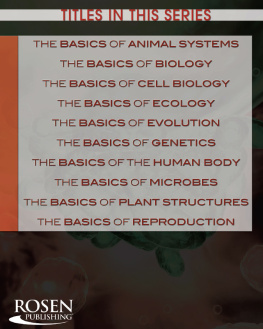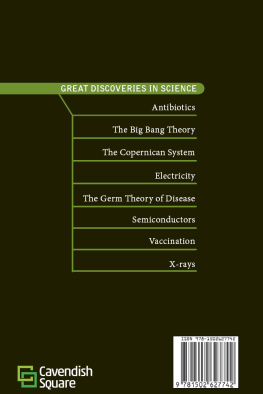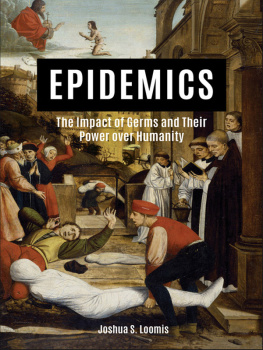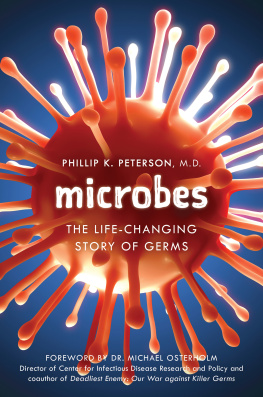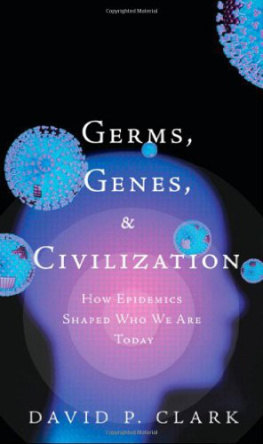
The Discovery of Germs
John Krieger
Published by Lyncean Publishing
Copyright 2021
ISBN: 978-1737967606
Introduction
Sickness lurks in filth and slime. The stagnant muck of sewers and swamps, or even a bad basement, threatens your well-being and maybe even your life. Living in cleanliness, sunshine, and fresh air is the way to good health. This much has been obvious to most people since primitive times. But what is it about foul places and stinky things that makes our inner functions go haywire? What exactly is the reason for our distress and discomfort? What is the cause of our disease?
Sometimes the cause of a sickness might be obvious we ate or drank something harmful, or we were bitten by a venomous creature. Sometimes poisonous substances enter our bodies, and that makes us sick. Or maybe we inhaled something we shouldnt have, something that was not fresh air. Disease has been associated with mists and odors and stinky marshes since ancient history. (Theres even a disease named bad air in Latin: malaria .) Maybe some diseases are caused by harmful poisonous fumes swirled into the air we breathe.
But there is another possibility. Maybe there are invisible living things, like bugs, but so small that we cant see them. And maybe they somehow get inside us and cause malfunctions in our internal machinery. Instead of invisible poisons hidden in our food or our air, maybe there are invisible living pests and parasites hidden in the environment around us. This living parasite explanation works especially well for plagues and epidemics. Sometimes there is a malady that spreads rapidly through a community, and we can explain this by saying that there are unseen living bugs passing from person to person. Maybe a plague is caused by tiny living creatures sweeping through communities of people the way swarms of locusts sweep across the land.
Even 1500 years before the invention of the microscope, this was not a particularly difficult guess to make. Sometimes we can observe infestations of worms living inside livestock. Sometimes we find that we have an itchy bug bite, but we never saw the bug. If there are harmful creatures barely large enough to see, maybe there are also harmful creatures even smaller than that.
But how could things so tiny that we can't even see them cause so much devastation? Mosquito bites are usually less bothersome than tiger bites. Being hit by a grain of sand is less damaging than being hit by a rock. What about creatures even smaller than a speck of dust? How could they be powerful enough to harm us? If our eyes cant see them when we look right at them, and our skin cant feel them when we touch them, how could they cause any damage to our lungs or our guts? Animals get sick, too, even animals much larger than we are. How could something we cant even see be powerful enough to bring down a huge cow?
Not all health problems are caused by an outside agent attacking us. Some problems seem to be associated with ones diet or temperament, and ancient scholars talked about an internal imbalance of humors as a cause of disease. (Today, we might talk about vitamin deficiencies or hormonal imbalances.) But many health problems seem to be due to a hostile outside factor. Since ancient times, people with scientific minds have looked at human disease and recognized that there is something out there. Somewhere out there is an unseen agent of disease, spread around the world and threatening us from its hiding place. It often seems to reside in rotting things and smelly places, and we naturally try to avoid these things. But what is this invisible dangerous something? The scholars suggested different answers. Some guessed that this agent of disease was like an airborne poison, and they talked about miasmas. (Miasma comes from an ancient Greek word meaning defilement or pollution.) But there were a few others, scattered through Ancient Rome, Medieval Arabia, and Renaissance Europe, who guessed that this unseen thing was alive. Or at least as alive as seeds are. Instead of invisible poisons, some people guessed that there were invisible seeds floating around, like pollen perhaps, and when these seeds enter someone, they sprout or germinate into disease. These seeds are the germs of disease.
But nobody knew for sure. All anyone had was guesses, and all the scholars could do was bicker with each other. Whatever this something is, nobody could see it, nobody could watch how it worked, and nobody could do any experiments with it. Nobody could show, one way or another, what really caused disease. Without plenty of evidence and careful study, without scientific proof , there was no knowledge, and no cure.
Are infectious diseases caused by invisible living creatures, or are they caused by something else? To know for sure, in scientific terms, we need to prove a relationship between a cause and an effect. And that is not easy. Noticing a few tendencies and making a few guesses is not enough. Without plenty of detailed exploration, careful experimentation, and thorough thinking, there will always be doubts and objections. In the case of germs, the process of proof took centuries. Most scientists including most doctors and biologists doubted the existence of living germs until the late 1800s. The famous nurse Florence Nightingale, for example, did not believe in them. What follows is a brief story of a long struggle to prove the existence of invisibly small, living agents of infectious disease. This is the story of the discovery of germs.
The Microscope
In the year 1600, the world was filled with creatures great and small, and the smallest were the gnats and fleas, as they had been since history began. Every once in a while someone perhaps a squinting nearsighted person, or someone with a weak magnifier would observe tiny specks on a rind of cheese, or on someone suffering from chronic itch, and he or she would claim that these almost-invisible motes were actually alive. But they offered no proof or even convincing evidence, the Authorities denied the existence of living specks, and everyone else ignored these wild claims.
In the year 1600, humanity was still suffering from sporadic storms of deadly epidemics, with no clue about the true cause, and little power to evade them. London had lost over 20,000 of its residents during an outbreak of bubonic plague in 1563, and the plague was endemic in Constantinople for most of the 1500s. Neither the ancient Greeks nor any subsequent scientists had made much progress in discovering the ultimate cause of such natural disasters, much less in devising any kind of cure or prevention. Mankind was still helpless against the Wrath of Pestilence.
But 1543 was the year Copernicus published his theory about the earth circling around the sun, and by the year 1600, the Scientific Revolution had begun.
The Two-Lens Trick
If you have a transparent sphere (perhaps a glass bowl filled with water, or a large glass marble), and you look through it at something on the other side, the object you are looking at appears enlarged. This effect has been known for thousands of years. Reading stones and magnifying glasses are just reduced versions of transparent spheres. These simple magnifiers can be fun and beautiful toys to play with. But they only make things look a few times larger at most, and for most of history, they were useful mainly as a reading aid or an assistance for people with aging eyesight.
By the year 1600, Dutch spectacle-makers had become proficient at grinding and forming a variety of quality glass lenses, both concave and convex. One can imagine children (or adults) wandering through the workshops, playing with the lenses, and trying to see what happens when you look through two lenses at once. Many of these people probably found only blurry colors, and quickly gave up. But a few of them discovered that if you arrange the lenses just so, you are treated to something remarkable. Try holding a concave lens (maybe someones corrective eyeglasses) over your eye, and hold out a weak convex lens (i.e., a weak magnifying glass) in front of it. Try lining them up in your sight and looking through the pair of them at something far away. As you adjust how far away you hold each of them, you might discover that they make the distant object look closer and larger. Or look at a fly with a strong magnifying glass, then place a weak concave lens over your eye. With the right adjustments, you should be able to make the fly look even larger than you could with only the magnifying glass. Using a pair of lenses in the right way, you can extend the power of a simple magnifying glass. You can upgrade a toy into a powerful optical instrument. These discoveries were apparently made by several people independently within a decade or so of 1600. The first written documentation is a patent application filed by Hans Lippershey in 1608, but two-lens magnifiers may have been in use as early as 1590.
Next page

